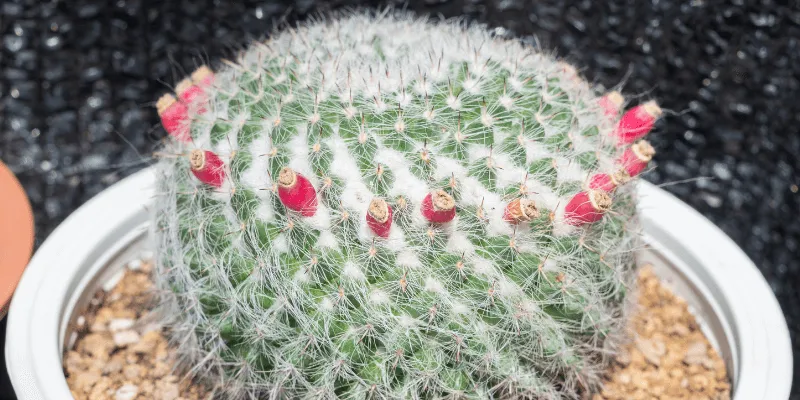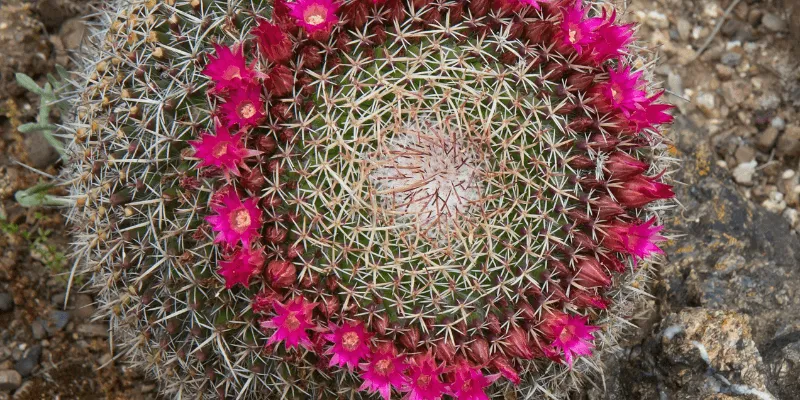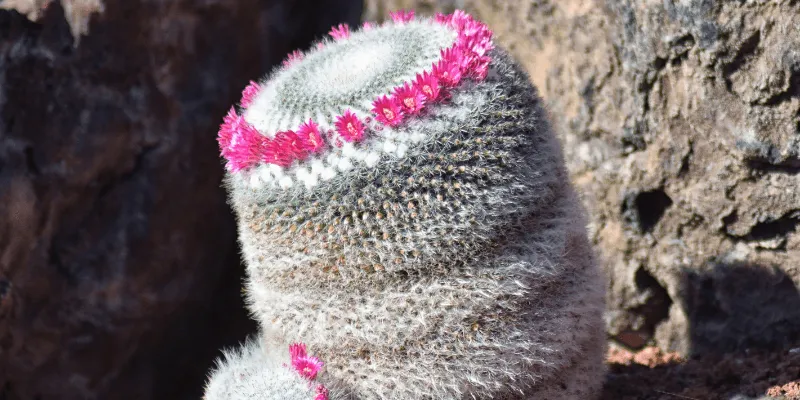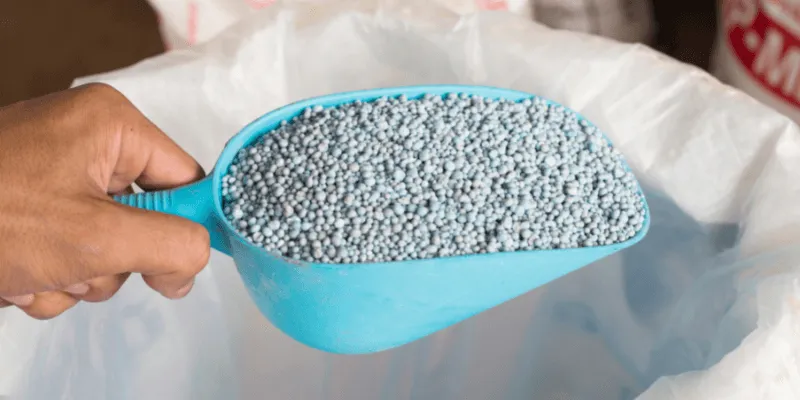Do you want to know about the most sought-after cactus in the world of gardening?
The Mammillaria Hahniana also goes by other names, including birthday cake cactus, old lady pincushion, and the most common name, the old lady cactus.
Once you lay eyes on the old lady cactus, you will see that there is nothing about it that resembles an old lady.
The reason for this unusual name could be because the entire cactus is covered with fine white hair-like spikes.
These ‘hair’ cover the entire plant and are kind of flexible. The plant’s hairs get longer, thicker, and richer as it matures. The hair can reach a maximum length of 5 cm and have a curly growth pattern.
This Mexican native is a member of the Mammillaria genus and can be grown both outside in warm environments and indoors as a potted plant.
The Old Lady Cactus symbolizes hope and endurance since it can survive extreme conditions and produce delicate and precious flowers in contrast to its needles.
If you are looking to enhance your cacti collection, the old lady cactus makes an excellent choice and will always remind you of hope.
So, here is all you need to know about the old lady cactus, its care, growth, maintenance, and propagation.
Table of Contents
Everything You Need to Know About Old Lady Cactus

The old lady cactus consists of over 30 white spines on each areole. The entire appearance looks something like a tiny spherical cactus covered with fur-like snow.
These cacti reach heights of 4 inches and a width of 8 inches. It will produce cone-shaped hot pink blooms with vivid yellow centers in late winter or early spring that linger for a very long time.
The plant’s top may develop a ring of blossoms creating a halo effect and resembling a beautiful headband.
Occasionally, little orange fruits will come next. This cactus frequently forms groups as it dislikes being alone, resulting in a cluster of spheres.
How to Propagate an Old Lady Cactus?

The optimal way to start growing your old lady cactus is by propagating it the right way.
While it is possible to grow these cacti using seeds and cuttings, offsets are the best way to do so.
Offsets are the more compact spheres that can be seen near the base of mature plants. Here is what you should do to propagate correctly.
- Don a pair of heavy-duty gardening gloves.
- Locate the smallest offsets and carefully cut them off from the parent plant.
- Let the offset dry for a few days.
- As soon as you separate the offsets from the parent plant, apply some rooting hormone there.
- Fill a small pot with a cactus potting mix
- Now transfer the offset into the pot.
- For about four weeks, give it a small amount of water per week.
Keep in mind to keep it away from direct sunlight while propagating.
After the offset has taken hold in the soil and grown its roots, you can expose it to sunlight; however, gradually increase the daily exposure.
The optimal time for propagation is just after the last frost, during early spring,
Old Lady Cactus Care Instructions
Although this sun-loving plant enjoys the outdoors, its environment can easily be replicated indoors.
In order to effectively replicate a desert atmosphere, you need to position it in a warm, sunny spot throughout the summer, ideally adjacent to a heat source.
If you could set your old lady cactus close to a windowsill that faces the south, it would be ideal. However, you will still have to be cautious since places near the windows tend to feel colder than the rest of the house.
To find the best place for your plant inside, you can move it around and make out where it is happiest, and that can be its permanent spot.
Sunlight Requirements

If you’re growing the old lady cactus inside, the best approach is to make sure it receives consistent, balanced light during the day.
Place it in front of a window in a location that receives consistent and constant sunlight.
If your house doesn’t have a place with adequate sunlight, you can purchase a grow light which will help all the other plants you have around as well.
Outdoors is the favorite place for an old lady cactus. Similar to other cacti, she loves the sun, but if the sunlight and heat get too intense, she may seem visibly depressed.
The old lady cactus only requires a minimum of 4-6 hours of sunlight every day, which means that planting it outside is a good idea.
Remember to place it under the shade of a few taller plants so that it will be protected during extreme heat and harmful sun rays.
Watering and Soil Needs

The watering needs for an old lady cactus are the same as all other cacti.
Only water it when the soil has completely dried out. Overwatering the cactus can lead to root rot which can eventually kill your plant.
Even if you feel the slightest bit of dampness on the soil, resist watering the plant. When you feel the soil is completely dry, water it ensuring it percolates through the soil.
Watering is also impacted by the weather. Your plant will require less water as the temperature drops.
The optimal seasons for watering your plant are summer and spring. Your old lady cactus doesn’t need any watering throughout the winter season.
The soil you choose can have a big impact on how well your cactus grows since it can retain water. You require soil that drains quickly, is porous, and is nutrient-rich as well.
A cactus potting mix should be ideal, and you can easily make it at home as well. The perfect potting mix necessitates equal parts sand to encourage drainage.
Fertilizer Requirements

When applying fertilizer to your cacti, timing is key. It is important that you only provide the old lady cactus with fertilizer during its growing season, which is summer and spring.
Growth stops during the winters as the plant becomes dormant.
The reason why fertilizer should be added during spring and summer is because of one reason only; blossoming flowers!
Your cactus’ blossoms won’t bloom if you fertilize it; however, keep in mind that less is more, and a mild liquid fertilizer should be enough.
For the plant to thrive, flourish, and bloom, a high potassium fertilizer is recommended.
You can also provide your cactus with nourishment if you feel the roots need a bit of support to regain their health.
Repotting Promotes Optimum Health
With all that’s going on above the surface of the soil, it is easy to forget about the most important aspect of a plant, the roots.
It is essential that you take a peek down below underneath the soil to examine the health of the cactus and help it live longer.
Repotting your old lady cactus will ensure that it remains healthy, happy, and thrives for years to come, and the perfect time to do it is during the summertime. Here is how:
- Ensure the soil above and under the surface is completely dry.
- Always use gloves while handling a cactus.
- Hold the cactus from its base, and shake it gently to loosen its hold in the soil.
- Start pulling it to safely remove it from the soil.
- You can now easily spot the dead or potentially decaying roots once the plant is removed from the pot.
- Use sterile scissors to cut off the decaying or rotten roots and apply an antifungal.
- Gently brush away the remaining soil from the roots.
- Prepare a fresh pot with a new, clean potting mix.
- Now transfer your cactus into the new pot.
- Do not water your repotted cactus for at least a week.
- Once the cactus has settled in its new soil, proceed to water it as you did before.
Fun Facts
- The Mammillaria genus has around 200 species that bloom in several different colors ranging from hot pink to violet, white, orange, and off-white.
- If submerged in water for an extended period of time, the old lady cactus could completely lose its blooming ability.
- Fruits grow into little club-shaped fruits as they mature, resembling small red chili peppers.
- These fruits can be eaten and taste like strawberries, tangy and sweet.
- Once the fruits fall off easily from the cacti, they can be harvested and used for propagation.
- This precious cactus is on the verge of extinction due to the illicit collection of natural species and deforestation.
Wrap Up
Now you know that the old lady cactus is indeed an amiable plant that will give your house or garden an exotic aesthetic. Just make sure not to overwater this precious cactus as it is usually the only reason for the plant to die.
Remember, cacti thrive in arid regions and don’t need that much water.
This cactus is perfect for newbies and can be given as a thoughtful gift.
It’s important to keep in mind that not everyone likes these prickly shrubs, but if you really want to gift it, do it after it blooms so the receiver appreciates it just as much as you do; and develops a taste for these prickly beauties.
Understanding something and using it, when necessary, gives you power.
It’s time to put the technical concepts you gained from this article into practice and gain first-hand knowledge of caring for Mammillaria hahniana.

